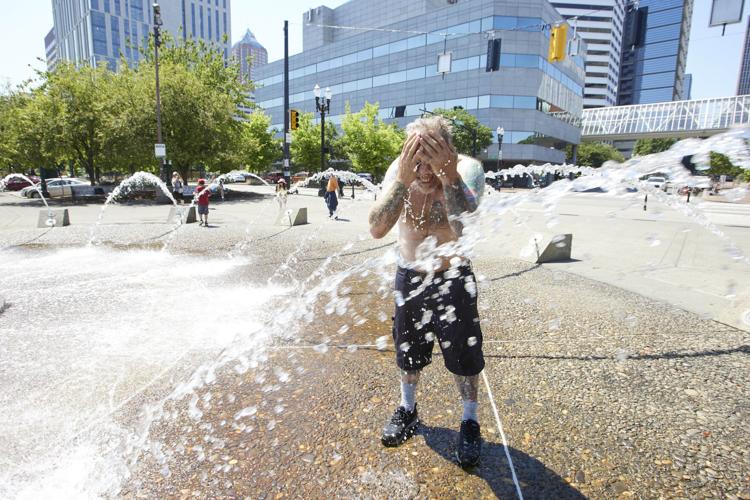Scorching heat wave extended in US Northwest

Scorching heat wave extended in US Northwest.
Portland, The Gulf Observer: The scorching heat spell in the Pacific Northwest is now expected to last longer than forecasters had initially predicted, setting parts of the normally temperate region on course to break heat wave duration records.
“We warmed up the forecast for the latter part of this week,” said David Bishop, a meteorologist for the National Weather Service in Portland, Oregon. His office is now forecasting up to 101 degrees Fahrenheit (38.3 Celsius) for Thursday, Friday and Saturday.
Portland already hit 102 F (38.9 C) on Tuesday, a new record daily high, prompting the National Weather Service to extend the excessive heat warning for the city from Thursday through Saturday evening.
Seattle on Tuesday also reported a new record daily high of 94 F (34.4 C).
The duration of the heat wave puts Oregon’s biggest city on course to tie its longest streak of six consecutive days of 95 F (35 C) or higher.
Climate change is fueling longer heat waves in the Pacific Northwest, a region where weeklong heat spells were historically rare, according to climate experts.
Heat-related 911 calls in Portland have tripled in recent days, from an estimated eight calls on Sunday to 28 calls on Tuesday, said Dan Douthit, a spokesperson for the city’s Bureau of Emergency Management. Most calls involved a medical response, Douthit added.
Multnomah County, which includes Portland, said there has been an uptick in the number of people visiting emergency departments for heat-related symptoms.
Emergency department visits “have remained elevated since Sunday,” the county said in a statement. “In the past three days, hospitals have treated 13 people for heat illness, when they would normally expect to see two or three.”
People working or exercising outside, along with older people, were among those taken to emergency departments, the statement added.
People in Portland’s iconic food cart industry are among those who work outside. Many food trucks have shut down as sidewalks sizzle.
Rico Loverde, the chef and owner of the food cart Monster Smash Burgers, said the temperature inside his cart is generally 20 degrees hotter than the outdoor temperature, making it 120 F (48.9 C) inside his business this week.
Loverde said he closes down if it reaches above 95 F (35 C) because his refrigerators overheat and shut down. Last week, even with slightly cooler temperatures in the mid-90s, Loverde got heat stroke from working in his cart for hours, he said.
“It hurts, it definitely hurts. I still pay my employees when we’re closed like this because they have to pay the bills too, but for a small business it’s not good,” he said Tuesday.
Multnomah County said its four emergency overnight cooling shelters were at half capacity on Tuesday with 130 people spending the night. But anticipating more demand, officials have decided to expand capacity at the four sites to accommodate nearly 300 people. The overnight shelters will remain open at least through Friday morning.
William Nonluecha, who lives in a tent in Portland, sought out shade with some friends as the temperature soared on Wednesday afternoon. Nonluecha was less than a minute’s walk from a cooling shelter set up by local authorities but wasn’t aware it was open. He said the heat in his tent was almost unbearable.
His friend Mel Taylor, who was homeless last year but now has transitional housing, said during last summer’s record-breaking heat wave a man in a tent near his died from heat exhaustion and no one realized it. He’s afraid the same thing might happen this summer.
“He was in his tent for like a week and the smell, that’s how they figured out that he was dead,” Taylor said. “It’s sad.”
Residents and officials in the Northwest have been trying to adjust to the likely reality of longer, hotter heat waves following last summer’s deadly “heat dome” weather phenomenon that prompted record temperatures and deaths.
About 800 people died in Oregon, Washington and British Columbia during a 2021 heat wave that hit in late June and early July. The temperature at the time soared to an all-time high of 116 F (46.7 C) in Portland and smashed heat records in cities and towns across the region. Many of those who died were older and lived alone.
Other regions of the U.S. often experience temperatures of 100 degrees. But in regions like the Pacific Northwest, people are not as acclimated to the heat and are more susceptible to it, said Craig Crandall, a professor of internal medicine at the University of Texas Southwestern Medical Center.
“There’s a much greater risk for individuals in areas such as the Northwest to have higher instances of heat-related injuries and death,” Crandall said.
Crandall said people who are continually exposed to heat have certain bodily adaptations allowing them to cool off more efficiently. A main acclimation response is an increase in the amount of sweat released from sweat glands.
“The combination of lack of air conditioning and not being exposed to the heat and not having those adaptations” can put people in the Northwest more at risk during heat waves compared to warmer parts of the country, he said.
Portland officials have opened cooling centers in public buildings and installed misting stations in parks. TriMet, which operates public transportation in the Portland metro area, is offering free rides to cooling centers for passengers who cannot afford to pay.
Officials in Seattle and Portland on Tuesday issued air quality advisories expected to last through Saturday.
Further south, the National Weather Service issued a heat advisory on Wednesday for western Nevada and northeast California that is set to last from the late Thursday morning until Saturday night. Across the region, near record daytime high temperatures will range from 99 to 104 degrees F (37.22 to 40 C).


